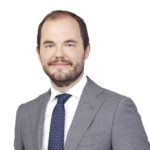

Twenty or so years ago, a London market marine underwriter declared he was going golfing one afternoon because he had reached his annual capacity level. That was an underwriting model commonly used in the Lloyd’s and London markets.
Underwriters sat in their boxes at Lloyd’s or at their desks and waited for risks to come to them. Once they achieved their business plan for the year, they spent their time as they wanted.
While that model of underwriting should be long gone, it still exists in the market, according to Mike Krefta, CEO of Hiscox Re and ILS in Bermuda.
“That is how an industry becomes disrupted. That is a level of complacency that encourages disruption and deserves disruption,” he emphasized in an interview with Insurance Journal.

“You can’t survive like that in a company. If you have that attitude, how do you go beyond your business plan. How do you grow? How do you show ambition to your junior staff? How do you drive a sense of progression through your company? You just can’t,” said Krefta.
The key, he said, is to maintain rigorous underwriting discipline during soft markets (when everyone is hunting for growth), hard markets (when business rolls across your desk) and everything in between.
“We try to avoid market pricing from a hard market/soft market perspective and consider whether there’s a sustainable level of pricing,” agreed Mike Mitchell, head of Property and Specialty Underwriting Reinsurance for Swiss Re, in a separate interview.
“At times, pricing can be unsustainably high, and there’s a correction around that. And sometimes, it’s unsustainably low.”
Mitchell said Swiss Re prefers to have dialogue with clients around the median area “where it’s actually healthier for the market as a whole to remain.”
Over the past several years of the soft market, Swiss Re saw a number of areas where prices fell below the sustainability barrier, he said. “Our response to that was to take some capacity out of the marketplace.”
This happened naturally as some reinsurance buyers sought to diversify their reinsurance security panels, and in many cases, it happened where pricing hasn’t supported Swiss Re’s view of risk capacity, he noted. “We’ve been quite comfortable to let that market share decline.”
Of course, one of the components of that pricing pressure—the unusual lack of Atlantic hurricanes—has now changed.
“The dialogue we’ve been having with our clients for some time around the sustainability of pricing levels is now supported by a normalized environment of loss activity.” As a result, the tone of the discussions has changed. Mitchell firmly believes that the market now has a signal to return prices to sustainable levels.
During softer market conditions, underwriters are often distracted by the difficulty in finding a risk-appropriate return, Mitchell added.

But, he warned, of even greater concern for underwriters during soft markets and hard markets is “understanding the rapid amount of change that we’re facing in many areas,” such as changes in technology, regulation or climate risks. All these uncertainties act to undermine “the credibility of the models underwriters use, the assumptions they use, to assess the cost of the products they sell,” he said.
The real challenges are working out “how to respond both proactively with product solutions but also from a risk analysis perspective to the multiple changes that the industry faces,” Mitchell noted.
Krefta and Mitchell agree there is a problem with how to manage the cycle, especially when young underwriters never have seen a hard market and probably won’t see one any time soon.
Even with collective insured losses of possibly more than $100 billion during the third quarter, some pundits do not believe the reinsurance market will see substantial price increases, given the amount of capital in the industry or poised to enter the industry from nontraditional investors.
For example, S&P Global Ratings predicts increases of as much as 5 percent on average in global pricing during the January 2018 renewals, with double-digit percentage increases possibly in store for affected regions and business lines. Prior to the recent catastrophes, S&P had expected a 0-5 percent rate decline into next year.
In other words, given the low starting levels from which rates could rise, this year’s spate of natural catastrophes is unlikely to lead to a widespread hard market, which several brokers have said is perhaps a phenomenon of the past. As a result, the industry will still have to deal with somewhat soft prices in next year’s renewals.
Krefta is concerned about the emerging problem where brokers and underwriters have not learned the art or science of broking or underwriting. “For brokers, there’s no challenge because if the underwriter is going to take the risk anyway, then they’re not learning how to broke fundamentally,” he added.
“Talents and skills are being diluted in a soft market cycle.” As an underwriter in a soft market, “if your approach is purely to write risk, are you going to scrutinize it to the same degree as you would when there’s an opportunity in a hard market when you can really expand your portfolio?” Krefta questioned.
“As a manager, you have to be incredibly disciplined in making sure that your underwriters, brokers, clients, operations people, finance people, etc., are training and learning their art form or skills they should have in any market environment.”
Another way to maintain discipline is by not tolerating sloppy work from brokers or underwriters, Krefta added.
He has heard brokers ask underwriters: “‘Do you want to write it or not?’ But the question…betrays what a good broker does. Equally, an underwriter who says, ‘OK, I’ll write it because I don’t have any other choice,’ is not giving the right answer,” Krefta said.
“There has to be a proper broke. Even in a soft market, there has to be a proper level of diligent underwriting. Discipline should not be diluted and tolerance of that should be very small,” he continued.
Every soft and hard market cycle is different, “just like every global recession is different,” Krefta emphasized. “It might be the same principle, which is that prices fall and excess capacity is constrained, or the reverse. But the reality is that the reasons for why that has occurred are different and insurance and reinsurance underwriters need to understand the market dynamics that drive those cycles.”
During his career, Mitchell said he has seen several hard market cycles and he is very focused on managing cycles and helping young underwriters build their knowledge.
“One of the strengths of the Swiss Re organization is that we do have access to a deep pool of talent and experience and we also have a very strong focus on ensuring that that experience and knowledge is shared broadly within our community.”
“We have employed a very large number of new talent who haven’t seen and experienced all markets and all cycles,” Mitchell said. “But we have been lucky to retain a strong contingent of very experienced underwriters. There is a very important part of our culture, which is around knowledge sharing and mentoring, which we take very seriously across the underwriting community.”
When market cycles occurred in Australia, New Zealand, Japan and Thailand—his previous areas of responsibility—Swiss Re actively worked to transfer the learning from those events, both on the underwriting side and the claims management side. (Mitchell became head of Property and Specialty Reinsurance on July 1, 2017. He previously led client management and underwriting units in Swiss Re Asia).
“As just one example of our knowledge sharing, we ran a comparative analysis of New Zealand and Turkey as earthquake environments, and one of our key underwriters from the Australian operation went and spent time with the Turkish team to talk them through the learnings from the New Zealand event,” Mitchell recalled.
These are regular and ongoing underwriter development programs, he said. “We try to ensure that the thing that we have that is most important at Swiss Re, which is our knowledge, is transferred first within our community and then with our clients through ongoing dialogue.”
Hiscox’s approach is to build a training toolkit for people because not everyone learns in the same way, Krefta said.
“We’ve developed a toolkit that people can dip in and out of, either because you think as a manager that they need to, which is more of a stick…or more of a carrot where people choose training because they acknowledge they are weak in a certain area.”
An internal training program is provided to new employees to provide a decent foundation for new joiners, Krefta said. “We also use external training, whether it’s executive learning or executive MBAs for the more senior people.”
“In addition, we have internal leadership programs. We have mentoring, which is a good tool to harness the experience of others, and executive coaching. We also have experiential learning, which includes stretching assignments or putting people on internal secondments,” he added.
Krefta said that moving people around the company—whether it’s geographically or across product lines—is essential to enhance their knowledge, preferably on a voluntary basis.
He advises young people to never stop learning and to maintain their learning agility. “It’s one thing to surround yourself with good, experienced people; it’s another thing to be a sponge that accepts their wisdom,” he added.
This article first appeared in Insurance Journal’s sister publication, Carrier Management.
Related: